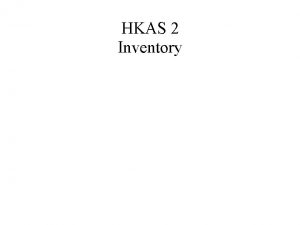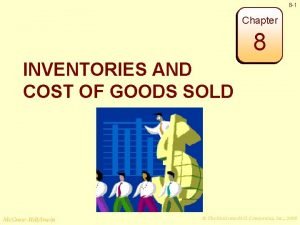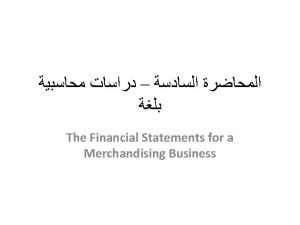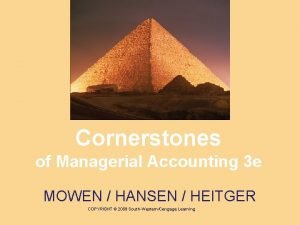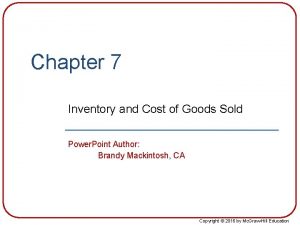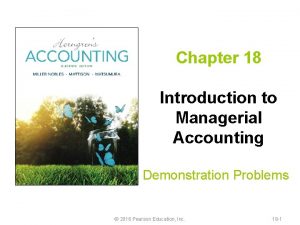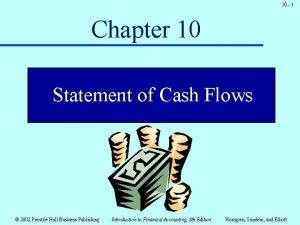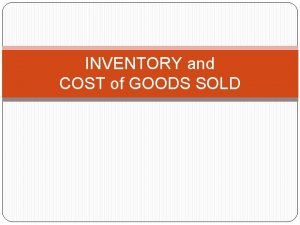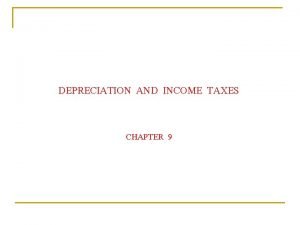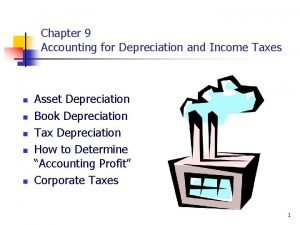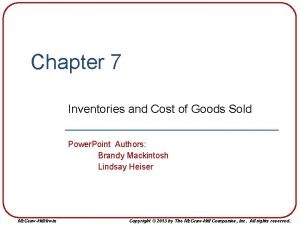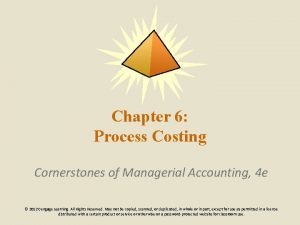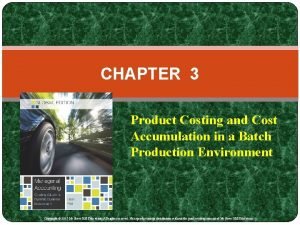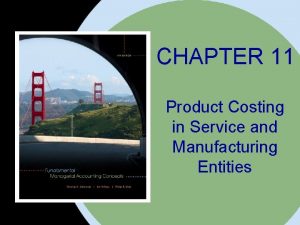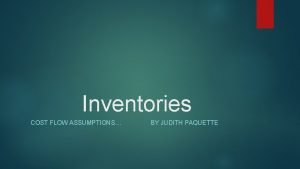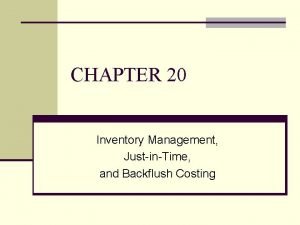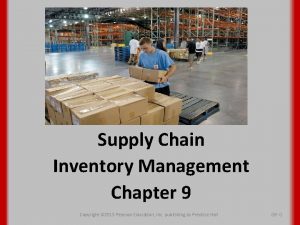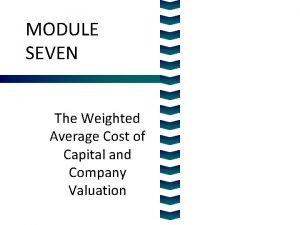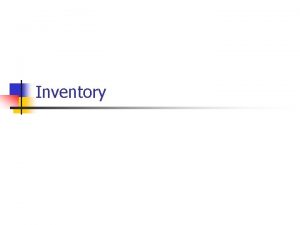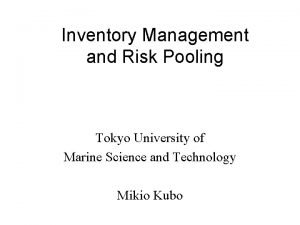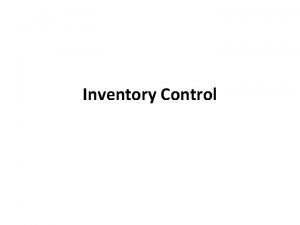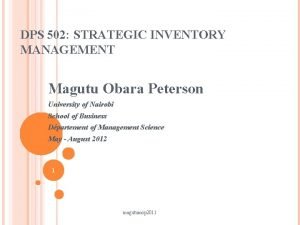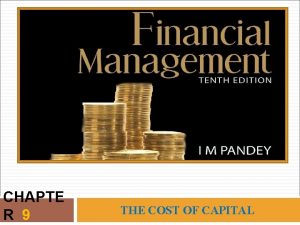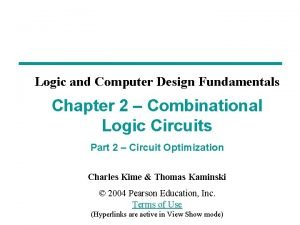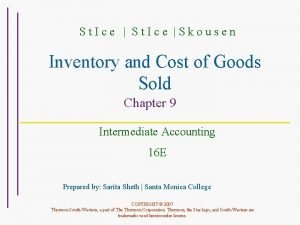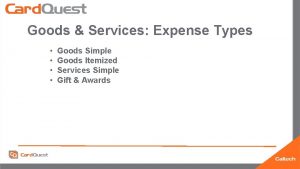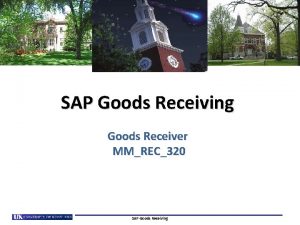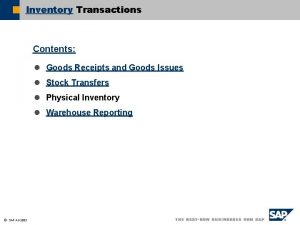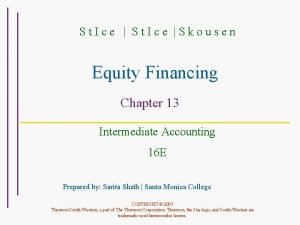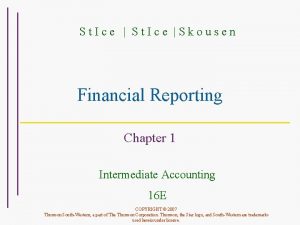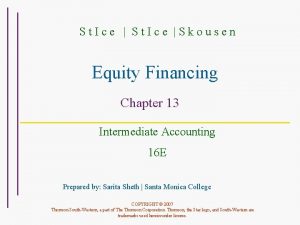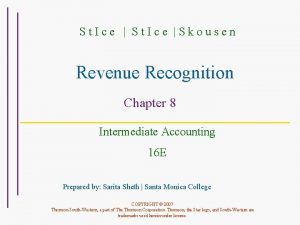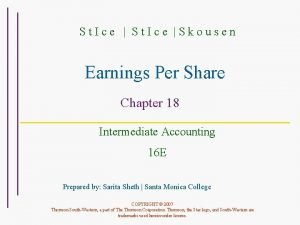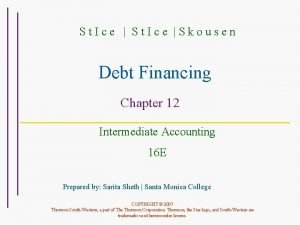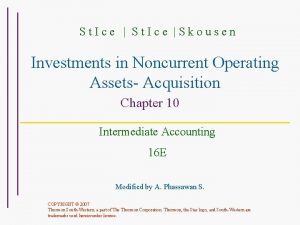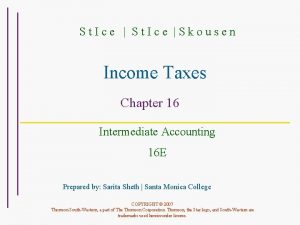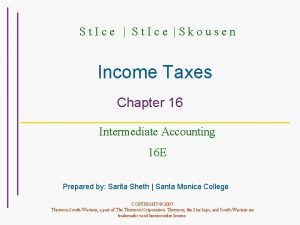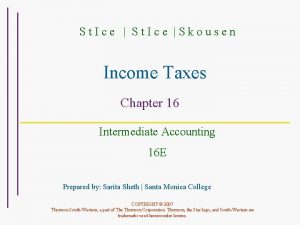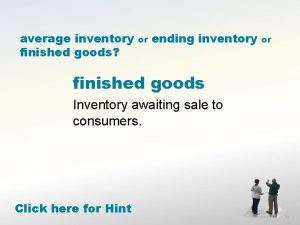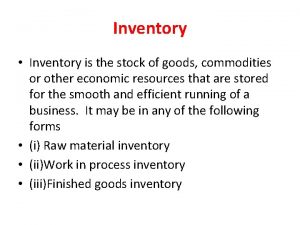St Ice Skousen Inventory and Cost of Goods



















































- Slides: 51

St. Ice |Skousen Inventory and Cost of Goods Sold Chapter 9 Intermediate Accounting 16 E Modified by Ms. Phassawan S. COPYRIGHT © 2007 Thomson South-Western, a part of The Thomson Corporation. Thomson, the Star logo, and South-Western are trademarks used herein under license.

Learning Objectives 1. Define inventory. 2. Explain the periodic and perpetual inventory system 3. Compute total inventory acquisition cost. 4. Use the four basic inventory valuation methods. 5. Apply the lower-of-cost-or-market (LCM) rule. 6. Use the gross profit method to estimate ending inventory.

Inventory Time Line BUY Raw Materials or Goods for Resale ADD Value SELL Finished Inventory COMPUTE Ending Inventory Cost of Goods Sold

What is Inventory? • Items held for resale in the normal course of business. • For a manufacturing firm, a broad array of production costs is included as part of the cost of inventory. – The terms raw materials, work in process, and finished goods refer to the inventories of a manufacturing enterprise.

Raw Materials are goods acquired for use in the production process. Materials that are used directly in the production of goods are frequently referred to as direct materials. Materials that are necessary in the production process but are not directly incorporated into the product are referred to as indirect materials.

Work in Process (WIP) consists of materials partly processed and requiring further work before they can be sold. The three cost elements that make up WIP are direct materials, direct labor and manufacturing overhead. Direct labor refers to the cost of labor directly identified with goods in production. Manufacturing overhead refers to the proportion of factory overhead assignable to goods in production.

Finished Goods Finished goods are the manufactured products awaiting sale. Income Statement Balance Sheet Direct Labor Raw Materials Work in Process Manufacturing Overhead Finished Goods Cost of Goods Sold

Summary Income Statement Items Balance Sheet Items Retailer Merchandise Cost of Goods Sold Sale Manufacturer Raw Materials Work in Process Direct Overhead Labor Finished Goods Cost of Goods Sold Sale

Learning Objectives 1. Define inventory. 2. Explain the periodic and perpetual inventory system 3. Compute total inventory acquisition cost. 4. Use the four basic inventory valuation methods. 5. Apply the lower-of-cost-or-market (LCM) rule. 6. Use the gross profit method to estimate ending inventory.

Inventory Systems • Two types of inventory systems 1. Periodic system- requires a physical count of the inventory periodically, and at the point of sale only records the sale price. – – – A seller records only the sales price. A seller has no record of how many units of inventory item have been sold. The only way to verify what inventory has been sold and what remains is to do a periodic physical count.

Inventory Systems • Two types of inventory systems 2. Perpetual system- at point of sale records selling price and type of item sold. Example: a bar code scanning system. – – – Both selling prices and the type of items sold are recorded for each sale. The seller knows the number of each items sold and on hand at the time of sale. The system offers a continuous check and control over inventories.

Differences in Recording Purchases of Inventory- Periodic Purchases Accounts Payable Sales During the Period- Periodic Accounts Receivable Sales 3, 000 4, 125 Purchases of Inventory- Perpetual Inventory Accounts Payable Sales During the Period- Perpetual Accounts Receivable Sales Cost of Goods Sold Inventory 3, 000 4, 125 2, 750

Differences in Valuing Cost of Goods Sold * From count Beginning Inventory Periodic System $ 500 + Purchases 3, 000 = Cost of Goods available for sale $3, 500 ** From records - Ending Inventory 700* = Preliminary cost of goods sold (COGS) + Cost of missing inventory $2, 800 Reported cost of goods sold $2, 800 Unknown Perpetual System $ 500 750** $2, 750 50 $2, 800

Differences in Valuing Cost of Goods Sold • The physical count serves to verify the accounting records. • There is the difference between the $750 inventory recorded in the books and the $700 physically counted. – A $50 lost in inventory may be as the result of recording errors, shrinkage, breakage, theft, and other causes.

Differences in Valuing Cost of Goods Sold • The entry to adjust the perpetual system inventory account for this shrinkage would be: Cost of goods sold Inventory 50 50

Learning Objectives 1. Define inventory. 2. Explain the periodic and perpetual inventory system 3. Compute total inventory acquisition cost. 4. Use the four basic inventory valuation methods. 5. Apply the lower-of-cost-or-market (LCM) rule. 6. Use the gross profit method to estimate ending inventory.

What Is Inventory Cost? • Inventory costs comprise of all expenditures both direct and indirect, relating to acquisition, preparation, and placement for sale. • Discounts can change the total inventory costs. 1. Trade Discounts 2. Cash Discounts

What Is Inventory Cost? 1. Trade Discounts • • Convert the catalog price to the actual price. Record inventory at discounted price. 2. Cash Discounts • • Granted for payment of invoices within a limited time period. Record inventory using the net method or gross method.

Net Method Gross Method 6/1 (at a time of purchase) Inventory 9, 800 A/P 9, 800 6/1 (at a time of purchase) Inventory 10, 000 A/P 10, 000 6/8 (paid within disc. period) A/P 9, 800 Cash 9, 800 6/8 (paid within disc. period) A/P 10, 000 Inventory 200 Cash 9, 800 6/28 (paid beyond disc. period) A/P 9, 800 Discounts Lost 200 Cash 10, 000 6/30 (not paid ’til end of month) Discounts Lost 200 A/P 200 6/28 (paid beyond disc. period) A/P 10, 000 Cash 10, 000 On June 1, Purchased merchandise for $10, 000; 2/10, n/30;

Purchase Returns and Allowances • Adjustments are Periodic Inventory System also made when Accounts Payable 400 goods are damaged or not Purchase Returns & lesser in quality Allowances than ordered. • Sometimes the Perpetual Inventory System customer returns the Accounts Payable 400 Inventory goods.

Schedule of Cost of Goods Manufactured Bartlett Corporation Schedule of Cost of Goods Manufactured For the Year Ended December 31, 2005 Direct materials: Raw materials Purchases Cost of raw materials available for use Less raw materials inventory, Dec. 31 Raw materials used in production Direct labor Manufacturing overhead: $ 21, 350 107, 500 128, 850 22, 350 $106, 500 96, 850

Schedule of Cost of Goods Manufactured Manufacturing overhead: Indirect labor Factory supervision Depr. —factory building and equipment Light, heat, and power Factory supplies Miscellaneous manufacturing overhead Total manufacturing costs Add work in process inventory, January 1 Less work in process inventory, December 31 Cost of goods manufactured $ 40, 000 29, 000 20, 000 18, 000 15, 000 12, 055 134, 055 $337, 405 99, 400 $366, 805 26, 500 $340, 305

Learning Objectives 1. Define inventory. 2. Explain the periodic and perpetual inventory system 3. Compute total inventory acquisition cost. 4. Use the four basic inventory valuation methods. 5. Apply the lower-of-cost-or-market (LCM) rule. 6. Use the gross profit method to estimate ending inventory.

Inventory Valuation Methods Specific Identification Cost Allocation Methods FIFO Average Cost LIFO

Specific Identification Method • Assigns the actual cost of the asset to Inventory and Cost of Goods Sold. • Provides a highly objective method of matching costs because cost flow exactly matches physical goods flow. • Is almost impossible to implement cost effectively.

Inventory Valuation Method Assume: Purchases: January 1 March 23 July 15 November 6 Total purchases Sales 200 300 500 1, 100 700 @ $12 @ $11 @ $13 @ $15 $ 2, 000 3, 600 5, 500 1, 300 $12, 400

Specific Identification Method 1 200 units @ $10 per unit Mar. 23 July 15 300 units @ $12 per unit 500 units @ $11 per unit Nov. 6 100 units @ $13 per unit Jan. 1, 100 units Sold 200 units from the January 1 and 500 from the July 15 purchase. ANS. Total cost of goods sold Ending inventory $7, 500 $4, 900

Average Cost Method • Assigns the same average cost to each unit sold and each item in inventory. • For periodic inventory, the unit cost is the weighted average for the entire period. • For perpetual inventory, the unit cost is computed as a moving average, which changes with each new purchase of goods.

Average Cost Method 1 200 units @ $10 per unit Mar. 23 July 15 300 units @ $12 per unit 500 units @ $11 per unit Nov. 6 100 units @ $13 per unit Jan. = = 1, 100 units $12, 400 1, 100 units = $11. 27 per unit (rounded) Cost of goods sold = $11. 27 x 700 = $7, 890 Ending inventory = $11. 27 x 400 = $4, 510 $ 2, 000 3, 600 5, 500 1, 300 $12, 400

First-In-First-Out (FIFO) Method • Assigns historical unit cost to Cost of Goods Sold in the order the costs are incurred. • Provides a close match between physical product flow and product cost flow. • Results in the same inventory valuation and Cost of Goods Sold regardless of whether perpetual or periodic inventory is used.

FIFO Method 1 200 units @ $10 per unit Mar. 23 July 15 300 units @ $12 per unit 500 units @ $11 per unit Nov. 6 100 units @ $13 per unit Jan. Total cost of goods sold $7, 800 Ending Inventory $4, 600

Last-In-First-Out (LIFO) Method • Assigns the most recent historical costs to Cost of Goods Sold and the oldest costs to Inventory. • Is used primarily to minimize taxable income. • Results in differences between Cost of Goods Sold and Inventory for perpetual inventory versus periodic inventory.

LIFO Method 1 200 units @ $10 per unit Mar. 23 July 15 300 units @ $12 per unit 500 units @ $11 per unit Nov. 6 100 units @ $13 per unit Jan. Total cost of goods sold $8, 000 Ending inventory $4, 400

Perpetual Inventory Assume: Beginning inventory Purchases: April 10 April 20 Sales: April 18 April 27 100 @ $10 $1, 000 80 70 @ $11 @ $12 880 840 90 50 @ $15 @ $16

FIFO Method- Perpetual Date Purchase unit $/unit Sales Total unit $/unit Balance Total 4/10 80 11 880 4/18 4/20 4/27 90 70 12 10 900 840 10 10 100 40 11 440 unit $/unit Total 100 10 1, 000 80 11 880 10 10 100 80 11 880 70 12 840 40 11 440 70 12 840

LIFO Method- Perpetual Date Purchase unit $/unit Sales Total unit $/unit Balance Total 4/10 80 11 880 4/18 4/20 4/27 70 12 80 11 880 10 10 100 840 50 12 600 unit $/unit Total 100 10 1, 000 80 11 880 90 10 900 70 12 840 90 10 900 20 12 240

Average Method- Perpetual Date Purchase unit $/unit Sales Total unit $/unit Balance Total 4/10 80 11 880 4/18 4/20 4/27 90 70 12 10. 44 940 840 50 11. 125 556 unit $/unit Total 100 10 1, 000 180 10. 44 1, 880 90 10. 44 940 160 11. 125 1, 780 11. 125 1, 224

Learning Objectives 1. Define inventory. 2. Explain the periodic and perpetual inventory system 3. Compute total inventory acquisition cost. 4. Use the four basic inventory valuation methods. 5. Apply the lower-of-cost-or-market (LCM) rule. 6. Use the gross profit method to estimate ending inventory.

Lower of Cost or Market • “market” means replacement cost (entry cost) = cost that would be acquired to replace an existing asset, e. g. the purchase price of the product plus all other costs incurred in the acquisitions of good. • As the selling prices (exit value) do not always respond immediately and in proportion to changes in replacement costs, the ceiling and floor constraints are placed on the use of replacement cost as the measure of market value of inventory.

Exhibit 9 -17: Market value = Replacement cost, constrained by the ceiling and the floor Selling price Less normal selling cost Ceiling Market value range Less normal profit Replacement cost Floor Condition: Market value > Floor, < Ceiling, and = RC when RC is between floor and ceiling

Lower of Cost or Market Item Cost Floor RC Ceiling Market LCM A $0. 65 $0. 55 $0. 70 $0. 80 B C D E 0. 65 0. 50 0. 75 0. 55 0. 60 0. 50 0. 45 0. 80 F 0. 90 0. 55 1. 00 0. 80 $0. 70 0. 60 0. 55 0. 80 $0. 65 0. 60 0. 55 0. 50 0. 75 0. 80

Item Units cost Market LCM Indi. Category Total inventory Category A A 1, 000 $650 $700 B 1, 000 650 600 C 1, 000 650 550 3, 000 1, 950 1, 850 $650 600 550 $1, 850 Category B D 1, 000 550 E 1, 000 750 800 F 1, 000 900 800 3, 000 2, 150 6, 000 $4, 100 $4, 000 Total 500 750 800 $3, 850 2, 150 $4, 000

Lower of Cost or Market • The journal entry to record the write down of the inventory based on (1) Individual item basis Loss from decline in value of inventory Inventory 250 **loss = shown as a separate item on the I/S or part of COGS.

Lower of Cost or Market • The journal entry to record the write down of the inventory based on (2) Category/Entire inventory basis Loss from decline in value of inventory 100 Allowance for decline in value of inventory 100 Cost of goods sold 100 (when company sells its entire existing inventory)

Learning Objectives 1. Define inventory. 2. Explain the periodic and perpetual inventory system 3. Compute total inventory acquisition cost. 4. Use the four basic inventory valuation methods. 5. Apply the lower-of-cost-or-market (LCM) rule. 6. Use the gross profit method to estimate ending inventory.

Gross Profit Method • Inventory estimation techniques are used to generate inventory values when a physical inventory count is not practical. • The gross profit method is based on the observation that the relationship between sales and cost of goods sold is usually fairly stable.

Gross Profit Method Exhibit 9 -18: Two-step process Cost of goods available for sale (Actual) Sales (actual) Estimated COGS (1) Estimated COGS (2) Estimated Gross Profit Estimated Ending Inventory

Gross Profit Method Beginning inventory, January 1 Sales, January 1–January 31 Purchases, January 1–January 31 Historical gross profit percentage Last year Two years ago Three years ago $25, 000 50, 000 40 % 37 42 Last year’s 40% is considered a good estimate.

Gross Profit Method Sales (actual) Cost of goods sold (estimate) Gross profit (estimate) Beginning inventory (actual) + Purchases (actual) – Cost of goods available for sale (actual) – Ending inventory (estimate) = Cost of goods sold (estimate) $50, 000 30, 000 $20, 000 100 % 60 % 40 % $25, 000 40, 000 $65, 000 35, 000 $30, 000

Gross Profit Method Sales (actual) Cost of goods sold (estimate) Gross profit (estimate) Beginning inventory (actual) + Purchases (actual) – Cost of goods available for sale (actual) – Ending inventory (estimate) = Cost of goods sold (estimate) $50, 000 29, 000 $21, 000 100 % 58 % 42 % $25, 000 40, 000 $65, 000 36, 000 $29, 000

QUESTIONS
 Consumer products classifications
Consumer products classifications Examples of progressive taxes
Examples of progressive taxes Positive consumption externality
Positive consumption externality Publik goods
Publik goods Goods in transit are included in a purchaser's inventory:
Goods in transit are included in a purchaser's inventory: Chapter 8 inventories and the cost of goods sold
Chapter 8 inventories and the cost of goods sold A company has sales of 695 000 and cost of goods
A company has sales of 695 000 and cost of goods Tat sat temperature
Tat sat temperature Clear ice vs rime ice
Clear ice vs rime ice Financial and managerial accounting weygandt kimmel kieso
Financial and managerial accounting weygandt kimmel kieso How to calculate cost of goods transferred out
How to calculate cost of goods transferred out Cost of goods sold formula
Cost of goods sold formula Beginning inventory formula
Beginning inventory formula Cash flow statement
Cash flow statement Carriage outwards
Carriage outwards Cost of goods sold depreciation
Cost of goods sold depreciation Cost of goods sold depreciation
Cost of goods sold depreciation Cost of good sold formula
Cost of good sold formula How to calculate cost of goods transferred out
How to calculate cost of goods transferred out Manufacturing overhead cost
Manufacturing overhead cost Underapplied overhead
Underapplied overhead The three most common inventory cost flow assumptions are
The three most common inventory cost flow assumptions are Merchandise inventory turnover
Merchandise inventory turnover Backflush costing
Backflush costing Weeks of supply formula
Weeks of supply formula Weighted average cost inventory
Weighted average cost inventory Total inventory cost formula
Total inventory cost formula Risk pooling formula
Risk pooling formula Holding cost of inventory
Holding cost of inventory Minimum inventory cost formula
Minimum inventory cost formula Cost accumulation and cost assignment
Cost accumulation and cost assignment Cost accumulation and cost assignment
Cost accumulation and cost assignment Cost pools
Cost pools Cost accumulation and cost assignment
Cost accumulation and cost assignment Dennis geyer
Dennis geyer Standard costing features
Standard costing features Distinguish between average cost and marginal cost
Distinguish between average cost and marginal cost Cost control and cost reduction difference
Cost control and cost reduction difference Job order cost system vs process cost system
Job order cost system vs process cost system Ordering cost and carrying cost
Ordering cost and carrying cost Difference between opportunity cost and trade off
Difference between opportunity cost and trade off Cost control and cost reduction project report
Cost control and cost reduction project report Cost control and cost reduction project report
Cost control and cost reduction project report Cost structure refers to the relative proportion of
Cost structure refers to the relative proportion of Manufacturing cost vs non manufacturing cost
Manufacturing cost vs non manufacturing cost Job costing vs process costing examples
Job costing vs process costing examples Flotation cost in cost of equity
Flotation cost in cost of equity Cost concept and classification
Cost concept and classification Manufacturing cost vs non manufacturing cost
Manufacturing cost vs non manufacturing cost Voh cost
Voh cost Flotation cost in cost of equity
Flotation cost in cost of equity Literal cost gate input cost
Literal cost gate input cost




